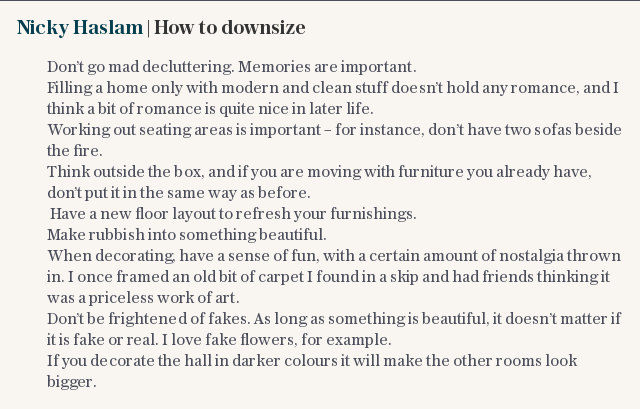Döstädning… the Scandi lifestyle trend for anyone who knows a hoarder

Following in the footsteps of hygge, the latest Scandinavian life philosophy is a little less cosy. Döstädning is the Swedish practice of ‘death cleaning’, a Scandi-noir version of Marie Kondo’s decluttering. And it’s not something we should put off until we near the end – döstädning is a task for now.
In her influential book The Gentle Art of Swedish Death Cleaning, published in the UK at the start of the year, Margareta Magnusson explains that as part of getting older, we should start looking at our possessions through the baleful lens of mortality.
When sorting through your clothes and books, instead of asking whether they spark joy, consider whether you will ever read or wear them again before you die. If not, get rid. And if your sentimental clutter won’t make someone else happy when you’re gone, that goes, too.
When my own mother died aged 77 a couple of years ago, it took me months to clear the chaotic house she had left behind, so in theory döstädning is a wonderful idea, and one I fully intend to practice myself. I don’t think I’m unusual in feeling this way either.
In writing a book about sorting through my mother’s life and possessions after she died, I’ve had a lot of conversations with friends and acquaintances, and even people I’ve met on the train, about their similar experiences. Almost every single one of them has vowed, like me, not to leave such a burden behind. They’ll be doing death cleaning even if they didn’t know it had a name.
When sorting through your clothes and books, consider whether you will ever read or wear them again before you die — if not, get rid
The only problem with this whole set up is that the ones who do it won’t be those who need it most. People like my mother.
My mother had always loved things, but this gradually metamorphosed from antiques through clutter into hoarding. For the last few years of her life, she wouldn’t even let me and my brother through the front door. Her death left us a house filled to the brim with old papers, books, cardboard boxes, unopened post and plastic bags, but intermixed with all the junk were treasures.
Precious family photographs were sandwiched between yellowed receipts, 18th-century glasses were buried under broken shelves. Every last item had to be sifted and examined, just in case. If there were ever a case for döstädning, my mother’s house was it.
In the long days I spent sorting and bagging and taking trips to the dump, I had too much time to think about inheritance and what it means. All too many of us end up despairing at the mounds of unwanted stuff our parents leave behind them, but it wasn’t always so. Our horror is a complete inversion of what our grandparents and their forbears felt.

For most of history, possessions were few and valuable. An additional chair or a bedcover was not a nuisance to be hidden away or disposed of but a valuable addition to the household. When Shakespeare famously bequeathed his wife Anne Hathaway the "second-best bed", this was a genuine gift, not a veiled insult.
Even clothes were welcome. One historian recently calculated that a pre-industrial linen shirt was worth the extraordinary sum of £3,500, the cost of all the labour which went into spinning, weaving and sewing it. Every scrap of fabric would have been cherished. My mother’s clothes and sheets went either to the charity shop or in the bin.
Her furniture wasn’t valued much more highly. After my parents divorced, my mother moved into a small Regency terraced house in Worcester, where she remained for the last 34 years of her life, and took great pleasure in furnishing it correctly, most notably in the dining room where she installed an oval 18th-century table and matching chairs.
At the time, these were an extravagance and an investment but nowadays – and for this we can probably also blame the Swedes with their airy modernism and blue furniture sheds: the burnished dark wood she loved has gone entirely out of fashion. I kept one small side table, for sentimental reasons, but could hardly persuade the auctioneers to take the rest of the furniture away, not even her precious table and chairs. Nowadays, no one wants to inherit what my mother left behind.

People are reluctant to inherit furniture, but they don’t even want the memories of their parents either. Even Margareta Magnusson discovered this: she had thought that at least one of her children would take the kitchen table around which they’d grown up, but not one of them did.
My mother’s house, too, was full of souvenirs, some of which meant nothing at all to me. But do I wish that she’d practised Swedish death cleaning, purging her house of all those useless possessions which meant nothing to anyone but her? Or should she at very least have packed them in a box marked “To Be Thrown”, as Magnusson advises?
When I was first faced with clearing her house, I would have wished for this with every atom of my existence, but, even so, I would have been asking the impossible. Despite years of trying, I hadn’t even persuaded my mother to clean up her own kitchen. Forcing her to face up to death while at the same time having to decide what to do with each and every thing she owned would have been too much for her even to contemplate, never mind accomplish.

Two years on and with the house cleaned and sold, I’m glad she never tried. I could have lived without the mountains of newspaper and junk mail, the old tights and the Tupperware, but much of what she left held meaning for me, just as it had done for her. In piecing together my mother’s life from her stuff, I learned a lot, not just about who she had been but about our relationship as well.
More than that, this sifting-through of things has become one of the rituals of modern mourning, one which dampens the shock of death. While someone’s house and possessions are still in place, as they were in life, we are able to feel that they have not yet fully left the world. My mother died suddenly, and this limbo time in her house gave me a space in which I could come to terms with her going, while her spirit still resided in her things. Despite the bin bags and damp, I am now very grateful to have done the work.
My own affairs are in better order than my mother’s, and I hope not to leave such a mess behind me for my husband and daughter when I die. At the same time, I know that I inherited some of her character along with her stuff. I too love to surround myself with objects, and hold on to memories in the form of things.

So when Margareta Magnusson urges me to think about what I am bequeathing the next generation, and how these associations will leave my possessions when I am gone, I don’t get the urge to throw them all away. Instead, I want to leave notes, put names to photographs and annotate all my souvenirs and heirlooms.
My family will not discover tidy boxes labelled “Keep” or “Throw”, but instead a forest of Post-It notes, each one ensuring that the meaning of things lives on after me. And I don’t think that’s what Swedish death cleaning is meant to achieve at all.
The Life of Stuff by Susannah Walker (Bantam Press, £14.99) is out now. To order your copy for £12.99 plus p&p, call 0844 871 1514 or visit books.telegraph.co.uk

